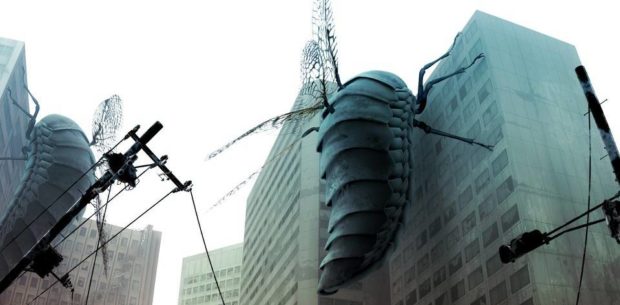A nightmarish collage of imagery greets audiences the moment ARAGE: SIGN OF VERMILLION (アラーニェの虫籠), a rare bit of anime auteurism from filmmaker Saku Sakamoto, who serves as director, author, screenwriter, animator, and music producer on the film. Drifting somewhere between a waking state and a dark dream, this independent animated feature might be rarity in Japan, but it also lacks the cohesion that would transcend this film out of its sleep paralysis.
Against the background of the outskirts of a factory town, the body of a female student is found amidst rumours of paranormal occurrences. Shy university student Rin (popular voice actor Kana Hanazawa) witnesses a bug emerge from an elderly woman. So begins a series of strange audiovisual happenings that could point to something even more bizarre, or it could be indicative of Rin’s mind starting to crack.
There’s a lot to admire about Sakamoto’s approach to this film. Known for his digital effects work on Ghost in the Shell 2: Innocence, the filmmaker used Kickstarter to help him crowdfund the completion of what he described as a “grossly underfunded” project. With industry supporters that include Takashi Shimizu (The Grudge), for whom Sakamoto did the opening sequence in his episode of The Great Horror Family, there’s been a fair bit of worldwide buzz around this one.
The brief feature works best as a character study of an unreliable narrator, with Rin’s medication causing dreams that “only last an instant.” As she grows to learn more about what is happening around her, from something called the Tilting Sickness (also a great band name – Ed.) to the nine types of spirit bugs, her madness seems less internal than we may have suspected. Just don’t expect this to make complete sense.
Sakamoto embraces the indie spirit with a mixture of animation styles. Some sequences are gorgeously rendered traditional animation, complete with stunningly realised backgrounds. The climax, for example, full utilises Sakamoto’s skills in digital design as we witness textured bugs crawling all over a ruined cityscape. At other points, everything devolves to an unfinished rough sketch, as if we are watching the original animatic workprint. Some scenes are somewhere in between, as the fully animated Rin runs through a Nightmare on Elm Street inspired factory chased by a buzz-saw wielding line-drawing. The effect works well for conveying Rin’s fractured worldview.
Given the experimental nature of the film, there’s no reason why anyone should demand abstraction to make sense, no more than one would from a David Lynch piece. Yet if ARAGNE is to be Sakamoto’s Eraserhead, it is destined to divide audiences in much the same way. Perhaps this is one of those pieces that will require multiple viewings to completely appreciate it. For the rest of us, once will be more than enough.
 2018 | Japan | DIRECTOR: Saku Sakamoto | WRITERS: Saku Sakamoto | CAST: Kana Hanazawa, Yosuke Ito | DISTRIBUTOR: Zelicofilm, Fantasia International Film Festival (Canada) | RUNNING TIME: 75 minutes | RELEASE DATE: 15 July 2018 (Fantasia)
2018 | Japan | DIRECTOR: Saku Sakamoto | WRITERS: Saku Sakamoto | CAST: Kana Hanazawa, Yosuke Ito | DISTRIBUTOR: Zelicofilm, Fantasia International Film Festival (Canada) | RUNNING TIME: 75 minutes | RELEASE DATE: 15 July 2018 (Fantasia)






